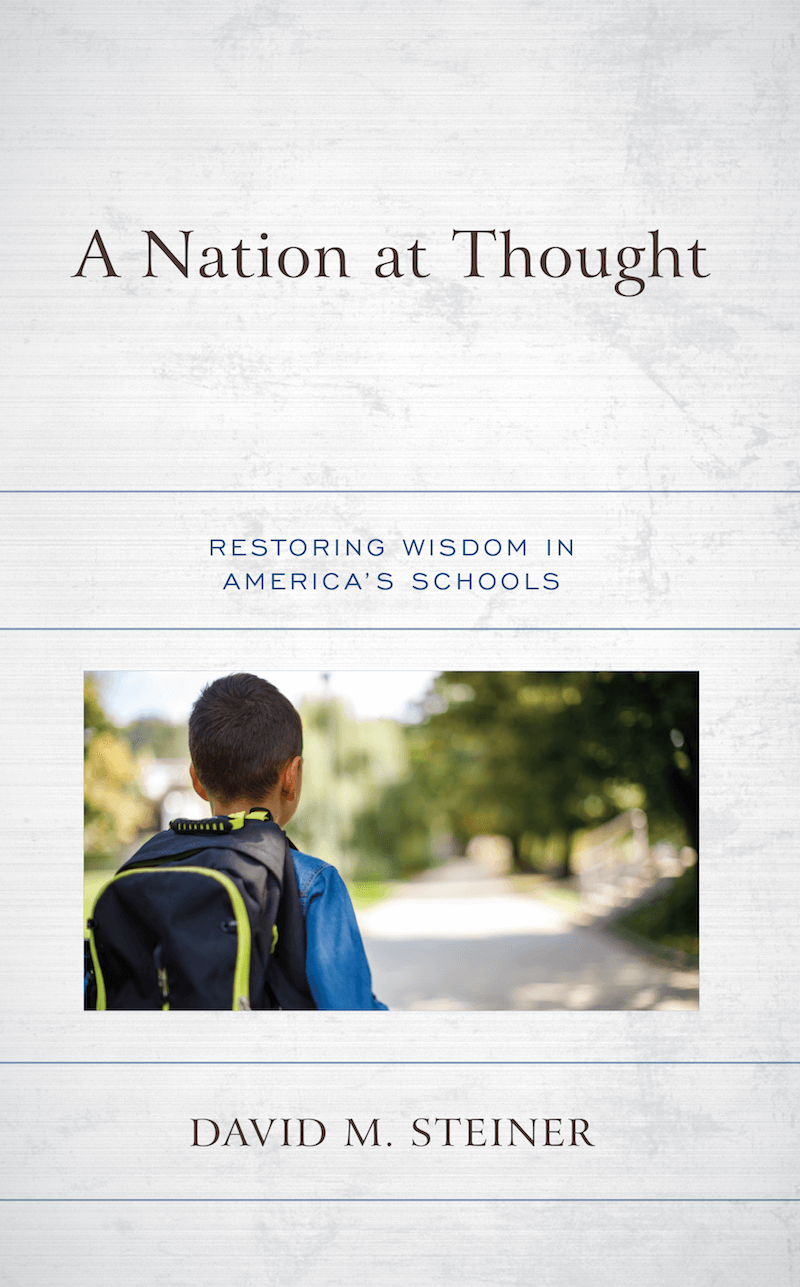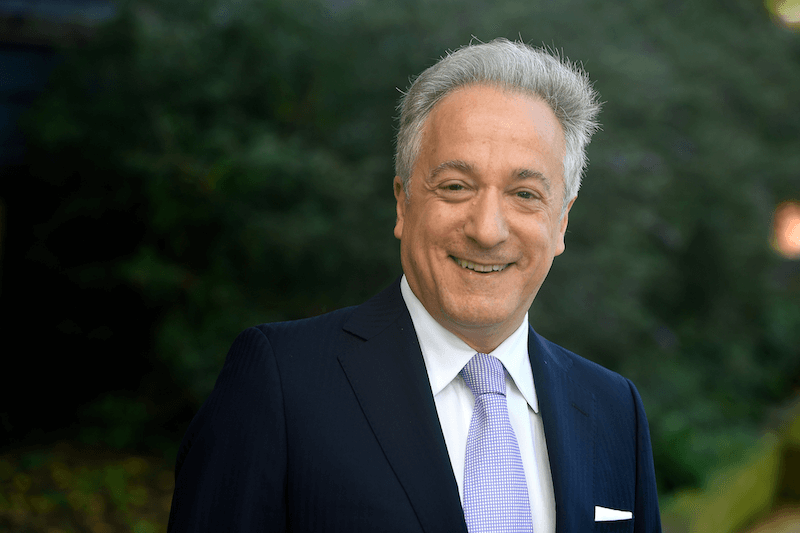
A Nation at Thought: Restoring Wisdom in America’s Schools
by David M. Steiner
Rowman & Littlefield, 2023, $80, 225 pages.
As reviewed by Matthew Levey
In the four decades since A Nation at Risk warned that American schools were failing, we’ve increased education spending, tried to improve curriculum and teacher training, unleashed market forces, attended to the “whole child,” and imitated Finland—among other efforts. Yet millions of K–12 students still read, write, and add as poorly as ever.
David Steiner, former head of Hunter College’s School of Education and later state education commissioner of New York, has seen it all, and now he offers his approach. As his book’s title signals, he believes the fundamental challenge is that high school students are not asked to think deeply enough.
 Based on his family history—which he elides—his concern is not surprising. David Steiner is not only an education scholar and administrator but also the son of George Steiner, one of the 20th century’s most revered literary critics and scholars of language. George Steiner was an unapologetic elitist. When he was six, his father taught him to read the Iliad. In Greek.
Based on his family history—which he elides—his concern is not surprising. David Steiner is not only an education scholar and administrator but also the son of George Steiner, one of the 20th century’s most revered literary critics and scholars of language. George Steiner was an unapologetic elitist. When he was six, his father taught him to read the Iliad. In Greek.
The apple fell right under the tree. David Steiner grew up in Cambridge, England, attended Oxford and Harvard, and went on to a career in academia, the arts, and education leadership. The state of K–12 education is grim, he tells us. But, borrowing from John Webster, one of Shakespeare’s lesser-known contemporaries, Steiner declares, “Look you, the stars still shine!” By “thinking further,” we can help children realize the pursuit of happiness promised them in the Declaration of Independence. We must ground education firmly in ethical reflection, aesthetic sensibility, and academic learning, Steiner tells the reader. “All three are crucial in forging a fulfilling life.”
Steiner believes every child can rise to the highest heights, if only leaders and educators aim higher. Schools should impart eudaimonia, “the shared and universal telos of human existence,” he writes. Guided by Aristotle, students should be taught to steer themselves, using reason. “In contrast to previous failed efforts at teaching explicit ‘rudimentary ethical systems,’” Steiner argues,
we need to reconsider ethical behavior from the ground up. Aristotle is especially helpful here because he directly links eudaimonia (human flourishing) and ethics. He also argues that it is our ability to employ reason guided by virtue that is indispensable to a well-lived life.
Steiner asks us to “imagine a student in front of a Rothko painting.” The student struggles because “there is no immediately accessible ‘meaning.’” She wants to walk on. “Aware of this reaction, the teacher prompts the student to stop, to encounter, to keep looking, making the student hyper-aware of what is going on in the visual encounter.” A high school run in accord with this vision would be a wonder to behold.
Steiner knows “raising educational outcomes will almost certainly lead to more students being overqualified for the jobs they will occupy.” Nonetheless, he writes, “a higher level of education is desirable because it represents an absolute good.” The thought reminds me of playwright Garson Kanin’s line, engraved on the sidewalk leading to the main branch of the New York Public Library: “I want everybody to be smart. As smart as they can be. A world full of ignorant people is too dangerous to live in.” Observing our current politics, many readers will agree with Steiner.
Steiner acknowledges that we have to ameliorate several problems with K–5 schooling before we can tackle his lofty goals for learning. Because phonics is not taught consistently, despite growing awareness of its foundational importance, students struggle to read fluently when they begin to encounter more-sophisticated books. Because curricula vary from classroom to classroom, students don’t build background knowledge from a set of common texts. Because advances in cognitive psychology are not incorporated into teacher-training programs, teachers are less effective than they could be.

The author recognizes that myriad “shiny distractions” like grit, growth mindset, and social-emotional learning further impede progress toward his vision. He worries that the public-education system’s “conflicted and fragmentary aims and disparate educational tools” make realizing his ideals “next to impossible.” Regardless, he says, “the most pressing problem in American K–12 education is that the teaching of academic knowledge in our middle schools, and still more so in our high schools, leaves students bored, undermotivated, and often unable to move beyond the most basic levels of understanding.”
If Steiner had supported this inspiring vision with the wisdom he has gained from experience, it would have strengthened the book. He curiously avoids recounting lessons he learned as dean of an education school and then education commissioner of one of the nation’s largest states. His support for Hunter College’s alternative teacher-certification program, developed in partnership with leading charter-school networks, garnered headlines and criticism. Did teachers certified under this program prove more effective than their traditionally certified peers? Does he think we should change the way teachers are certified in general? I agree that “policymakers and parents cannot give up pressing for . . . educational changes across the entire spectrum of public schools,” but Steiner provides few insights from his career as to how these reformers can be more successful at improving student outcomes.
A second challenge is that many parents don’t share Steiner’s aspirations for their children. They’re not philistines, but they define success differently—perhaps in terms of athletic achievement or working in a part-time job. Like it or not, the number of parents concerned that their high school graduate doesn’t understand Kant’s deontological ethics is small. American school governance tolerates such dissent, as we’ve seen in recent debates over how to teach about race, gender, and even the Holocaust. Sharing any lessons he learned about the compromises democracy demands would have enriched Steiner’s book.
Independently run schools like the one Steiner attended as a child can pursue academically demanding approaches because they do not serve all students. The closest public-school analogues in America are charter schools. Steiner knows of Success Academy, the largest charter network in New York, which makes no excuses for students or staff who don’t aim high. He cites charter schools’ academic achievements and popularity among Black families but doesn’t comment on whether Success or other charters could help realize his vision.
Finally, Steiner discounts the impact of curriculum reforms of the last decades. He praises the Common Core State Standards because they “insist on the importance of teaching decoding skills in early education” but then decries as “drastically reductive” standards that call for students to “analyze” and “determine” points of view or central ideas of a text. He concurs with E. D. Hirsch that “building a storehouse of knowledge is indispensable” to becoming a fluent reader but later calls Hirsch’s “overarching claim about the importance of background knowledge . . . flawed.” Steiner agrees that, to change society, students need to acquire the language and knowledge “of those protecting the status quo.” But Hirsch’s approach is too transactional for Steiner, producing “impoverished” English and history classes. Hirsch doesn’t demand enough of teachers, in Steiner’s view. Steiner wants students “to develop a more sophisticated experience of reading, and at an earlier age.” As a guide, he offers an excerpt from Book 10 of Plato’s Republic.
I share Steiner’s wish, but, having used Hirsch’s Core Knowledge Language Arts curriculum—which Steiner promulgated as exemplary—I can say teachers are still learning how best to teach reading; few are ready to follow the guidance of ancient philosophers. Hirsch’s transactional approach may not lift us to Steiner’s Platonic ideal, but it strikes me as a predicate step, and one that we do poorly, if at all, in most schools.
A system of school choice that allows sympathetic leaders to put Steiner’s vision into action and attract families might realize his admirable and beautiful ideals to some degree. That was my intention with the International Charter School, which I founded in Brooklyn 10 years ago. The Great Hearts network does similar work, at a larger scale, in Arizona, Texas, and Louisiana. Classical Charter in the Bronx is a third example. The school system imagined in A Nation at Thought would be a light unto nations, a city upon a hill, inspiring to us all. Alas, despite his decades of experience, Steiner includes little concrete advice on how schools might realize this inspiring dream.
Matthew Levey headed the International Charter School and writes on K–12 education.
This article appeared in the Summer 2023 issue of Education Next. Suggested citation format:
Levey, M. (2023). Think Deep, Aim High: A grand vision of American education, with scant practical advice. Education Next, 23(3), 72-73.


